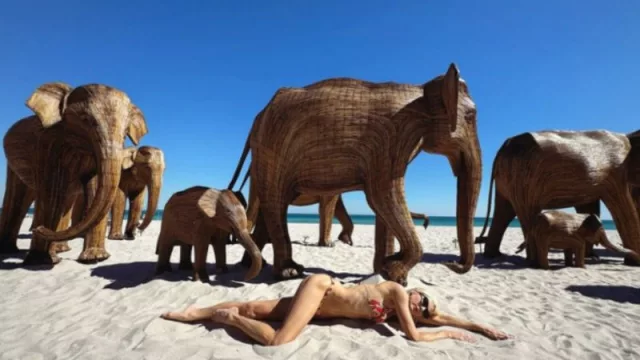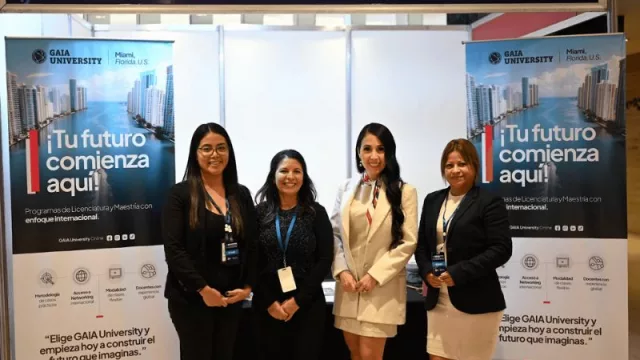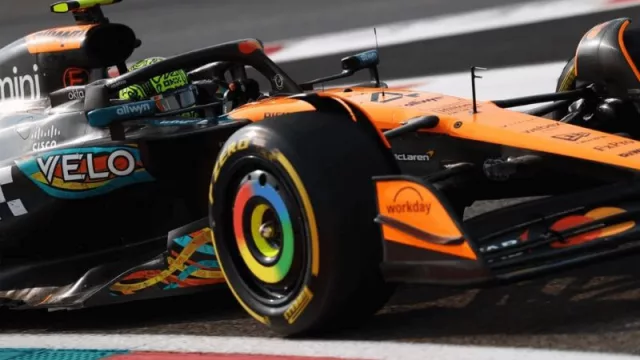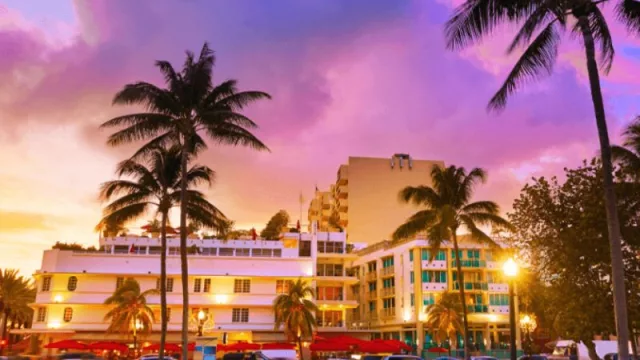Summary and Insights
The exhibition of “The Great Elephant Migration” is not merely a visual feast but a powerful reminder of our responsibility towards the planet and all its inhabitants. The fusion of art and conservation invites us to act, to become part of a larger movement seeking harmony between humans and nature. By visiting the exhibition, reflecting on our actions, and considering the purchase of one of these sculptures, each of us can contribute to a more sustainable future.
IG: @infonegociosmiami
Key Points:
-
The exhibition features 100 elephant sculptures created by indigenous artisans from India, utilizing invasive plant species.
-
The installation seeks to raise awareness about conservation and coexistence between humans and wildlife.
Highlights:
-
Visit the Exhibition: Don’t miss the opportunity to stroll among the elephant sculptures in Mid Beach.
-
Participate in the Cause: Consider acquiring one of the sculptures, with proceeds directed towards conservation projects.
-
Connect with Nature: Reflect on your relationship with the environment and how you can contribute to its protection.
The Installation: A Visual and Sensory Spectacle
The herd of sculptures is positioned in Mid Beach, between 36th and 37th Streets, as part of the renowned Miami Art Week 2024. “Each elephant has been crafted by nearly 200 indigenous artisans from the Bettakurumba, Paniya, Kattunayakan, and Soliga communities of the Nilgiri Biosphere Reserve in India,” the organizers highlight. This collaboration between art and tradition emphasizes the importance of cultural heritage in conservation.
“This is a monumental project that leaves people literally speechless upon first seeing it,” asserts Ruth Ganesh, chief trustee of Elephant Family and co-founder of The Real Elephant Collective, which spearheaded the installation. “It’s free and accessible to the public, allowing passersby to experience it right on the beach.” Audrianna Silvestri from New York captures images of The Great Elephant Migration, a stunning exhibition showcasing life-sized elephants in Miami Beach.
Displayed during Miami Art Week on the sands of Miami Beach at 36th Street, the concept of The Great Elephant Migration has been in development for over a decade, according to Ganesh. The installation aims to inspire conversations about coexistence, mirroring the way indigenous communities in India live alongside the largest terrestrial mammals. “I thought it was an incredibly inspiring story for the rest of the world to emulate with the animals in our environment,” Ganesh notes.
Additionally, to enrich the experience, the luxurious Italian fragrance house Xerjoff will present a perfume inspired by the flowers found in the habitats of Asian elephants. Each bottle sold will support the mission of coexistence.
An Ecological Awareness Message
The sculptures are crafted from lantana camara, an invasive weed that threatens biodiversity and displaces native flora. “This fast-growing, harmful shrub dominates 300,000 square kilometers of Protected Areas in India,” experts warn. Utilizing lantana in the creation of these sculptures is not only an artistic endeavor but also a strategy to combat this invasive species and provide more space for wildlife.
“We have been amazed by the affection and support the elephants have received,” Ganesh shares. “Some people are genuinely moved by their presence, demonstrating how wonderfully powerful they are.” The Miami Beach installation aims to inspire visitors to reflect on themes of tolerance, empathy, and coexistence. “We want people to walk among the herd, experience their astonishing presence and beauty, and visualize the places in the world where humans coexist with these giants,” Ganesh expresses.
“What better way to help the world visualize this story of coexistence than to bring 100 life-sized elephants across the United States?” The sculptures, made from lantana, an invasive weed from the forests of India that displaces native wildlife, transform this nuisance into art. The project not only supports conservation but also provides sustainable employment for local artisans. Each sculpture is inspired by a real elephant, capturing their unique personalities and appearances. Ganesh emphasized that this intimate knowledge stems from the artisans’ animistic beliefs and their deep connection with nature.
The installation seeks to amplify indigenous knowledge, inspiring humanity to “share space” with other species. This global movement aims to “protect endangered species and promote sustainable coexistence.”
The Role of Community and Art in Conservation
“The Great Elephant Migration” is a global initiative that unites communities and artists from around the world. “Each sculpture embodies a real wild elephant, highlighting their unique characteristics, much like humans,” emphasize the organizers. The narratives of each elephant invite visitors to contemplate the possibility of coexisting harmoniously with nature.
The sculptures are available for purchase, with proceeds directed towards organizations dedicated to conservation and coexistence, such as the Coexistence Consortium. “Every purchase supports vital on-the-ground efforts essential for the preservation of these species.”
The influx of visitors to Miami Beach for Art Week coincides with the unveiling of the elephants, leading Ganesh to anticipate strong interest in acquiring the sculptures. The proceeds from the sales will be allocated to support conservation organizations worldwide, with each elephant linked to a specific entity.
Donations range from $10,000 to $100,000 per NGO and will fund projects aimed at fostering coexistence between humans and wildlife, addressing issues involving lions, bison, jaguars, and more.
Frequently Asked Questions (FAQs)
When will the exhibition open?
The official inauguration will take place on Monday, December 2, and the installation will be available for viewing until December 8.
Where is the exhibition located?
The herd of sculptures is situated in Mid Beach, between 36th and 37th Streets.
- Contacts: [email protected] or [email protected]












Tu opinión enriquece este artículo: